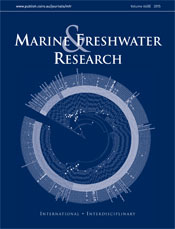Marine and Freshwater Research
Volume 66
Number 8 2015
Plastic pollution has become a global problem for marine ecosystems in recent decades. However, to resolve this environmental disaster will require changing the attitudes and lifestyles of people. Here we engaged a community to highlight the high levels of plastics that exist on their local beaches in an attempt to inspire local change.
We quantified and identified the allochthonous leaf litter entering a headwater Atlantic Rain Forest stream throughout 1 year. We found that most organic matter entered the stream by a lateral input pathway, driven mainly by precipitation, as well as by changes to the leaf litter input of tree species throughout the year.
In this study, pyrosequencing was used to investigate the diversity and composition of putative diazotrophs in the South China Sea. The result showed that Trichodesmium and γ-proteobacteria were the two dominant species among the putative N2-fixing microorganism community. The predominance of the two genotypes in the South China Sea contributed to low diversity of putative diazotrophs.
The breeding aggregation of the giant Australian cuttlefish (Sepia apama) in northern Spencer Gulf, Southern Australia, has declined dramatically since the turn of the century. Our analysis of long-term by-catch and harvest records for the population indicated that this trend was not due to the failure of the species to aggregate, nor due to the aggregation occurring elsewhere, but was part of a systemic decline in the abundance of the population over this period. We evaluated a suite of potential climatic and harvest-related stressors for this species but could not attribute this decline in abundance to specific causes.
Attached bacteria can play a major role in carbon and nutrient cycling but their importance differs among habitats. We investigated the dynamics of attached and free-living bacteria in the coastal waters of Malaysia, and found that attached bacteria formed a larger fraction of total bacteria in eutrophic relative to oligotrophic waters, and showed a preference for chlorophyll-a based particles.
Understanding the mechanisms that favour increase in phytoplankton biomass and bloom formation in freshwater ecosystems is a major challenge for managers and researchers, especially in environments dominated by cyanobacteria. Based on 5 years of observation, our study evaluated the importance of climatic factors in determining environmental conditions such as water level and mixing regime in a subtropical lake used for public water supply. The results show the importance of daily stratifications events for the accumulation of phytoplankton biomass.
Low summer oxygen in a highly eutrophic and seasonally hypoxic coastal bay was attributed to high phytoplankton stocks, together with high temperature and stratification of the water column. A distinct mesozooplankton community was identified in summer of large freshwater discharge. The abundance of a marine cladoceran was positively related to oxygen levels, suggesting that hypoxic conditions may have lethal or sublethal effects.
Sampling muscle is the prevalent technique for stable isotope analysis in fish and typically involves the death of the individuals. Fin-clipping is a non-lethal, easy-to-implement sampling technique that preserves fish welfare. This study assessed the suitability of caudal fin as a replacement for muscle in trophic studies. Results support the use of caudal fin as a surrogate for muscle but also showed that fin-muscle relationship varies among species and it is affected by fish size.
Reef-fish communities on large coral-reef systems are incredible complex; in contrast, isolated oceanic islands represent an opportunity to understand processes on ecologically simpler ecosystems. This study investigated the reef-fish community of the world’s smallest tropical oceanic island and found that environmental drivers, especially depth, are more important than biotic interactions in its organisation, probably because of low species-richness. The low-species richness translates in low functional redundancy, indicating that remote islands may be more vulnerable to human impacts than interconnected reef systems.
Laboratory feeding-preference experiments showed that the estuarine crab Sesarma catenata preferred decomposed leaves of terrestrial riparian trees, followed by decomposed and mature leaves of the marshgrass Spartina maritima. The relative low carbon : nitrogen ratios of S. maritima and high bacterial production associated with decomposed terrestrial leaves may explain the trophic behaviour of S. catenata.




